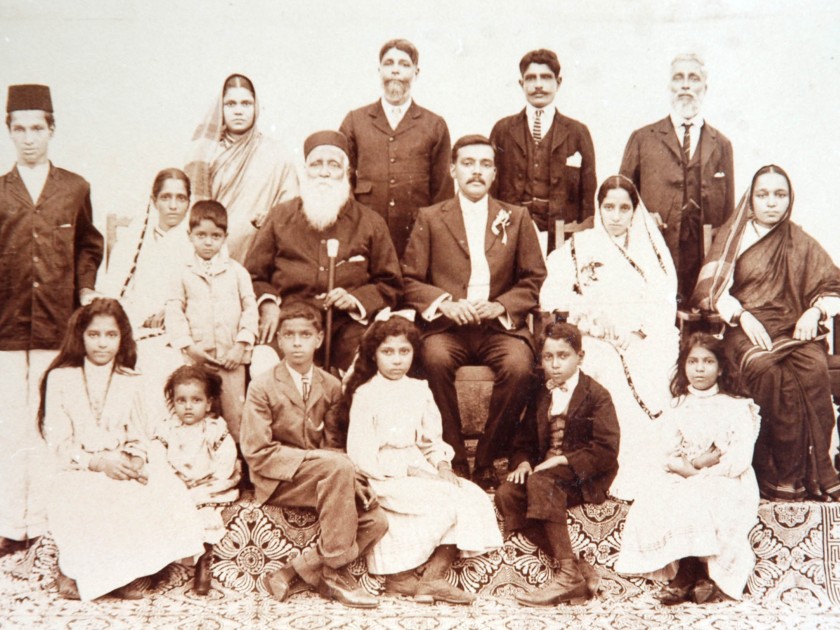
The author’s family photo with her great-grandfather, great-grandmother, grandfather, grandmother, and others. Courtesy of the author.
Every Hanukkah, I light my menorah and feast on fried samosas and vegetable patties. I look back at how my large family slowly disintegrated, though we used to live together in an old house in the walled city of Ahmedabad, India.
Over the years, my elderly relatives passed away, and other family members immigrated to Israel, Canada, England, Australia, and the United States. I also left Ahmedabad, many times, but kept returning and became part of the community of the last one hundred and forty Jews in the city. In a sense, we are like one family, meeting often and breaking bread together at the Magen Abraham Synagogue.
My ancestors lived in Ahmedabad for almost five generations. Later in life, I was responsible for disposing of their belongings. Giving away our grinding stone was one of the hardest moments of my life. It was precious, even if it was a slab of stone; it had the touch of all the women of my family inscribed on it. About fourteen by ten inches, it was kept on the floor or on the large kitchen platform. It was more than a hundred years old and had chisel marks on the surface so ingredients could be ground into a smooth paste. Over time, the marks had softened, as stone artisans were not easily available to roughen the surface. The pestle was also stone, cylindrical in shape, and just the right size for someone to hold it in both hands in order to grind masalas and chutneys.
The pressure of the human hand on the ingredients was essential; one needed to use strength and a continuous semicircular movement to give the blend the right texture. Ginger, garlic, fresh green chilies or dried red ones, grated coconut, cumin seeds, and coriander leaves were combined so that they could be sautéed with sliced onions and added to a casserole. It took special skill to grind onions, ginger, garlic, and peppercorns together to make a paste for black pepper curry.
This chore was assigned to the cook or her assistants, and if my female relatives were not satisfied with the result, they would hitch up their saris, sit down on a wooden stool, and grind the paste themselves. As they made green or red masala paste for a curry, they checked its consistency by rubbing a pinch between their fingers before it was cooked in coconut milk. Sometimes it was mixed with tamarind extract or strands of fragrant saffron dissolved in a tiny bowl of water. Once the curry casserole was set on the stove, pieces of chicken, fish, or meat were added, and a delicious aroma filled the house.
In a sense, we are like one family, meeting often and breaking bread together at the Magen Abraham Synagogue.
When I moved to an apartment, I tried to find room for the grinding stone. For a time, I even used it as a pedestal for some of my potted plants. Finally, I gave it to our former driver, whose wife needed one. Soon after, I bought an electric mixer-grinder that lets me process masalas in a few minutes, but they never seem to fully release their flavor.
When I polish my menorah, place it on a silk ceremonial textile, and return to the kitchen to fry vegetable patties, I am reminded of the green coriander chutney we used to make on the grinding stone to serve with them. Sometimes, even if I have not cooked chutney, the memory of its fragrance wafts toward me. This scent touches the inner chords of my being.
_______
Below find a recipe for vegetable patties and green coriander chutney. This chutney is often served with patties and can be made on a grinding stone. Check out Esther David’s latest book, Bene Appétit: The Cuisine of Indian Jews.
Hanukkah
Candles are lit to celebrate Hanukkah as patties, cutlets, potato pakoras, potato rolls, or samosas are served along with a variety of fried snacks.
Vegetable Patties
Ingredients
6 potatoes
½ cup green peas
1/4 teaspoon red chilli powder
½ teaspoon cumin powder
1 tablespoon chopped coriander leaves
Salt to taste
Eggs
Breadcrumbs
Refined flour
Oil
Method
Peel potatoes and shell green peas, steam-cook till done; drain, transfer into a bowl, mash; add red chilli powder, cumin powder, finely chopped coriander leaves, salt to taste and mix with oiled palms. Divide this mixture into equal portions and shape into round patties. Take another bowl, break eggs, whisk till frothy, dip each patty in egg mixture, then roll in a platter of breadcrumbs and refined flour and cover on both sides.
Heat oil in a pan; add patties, fry till both sides are golden brown, drain and serve hot.
Optional – Add 1 small grated carrot to the mixture of mashed potatoes and peas.
Green Coriander Chutney
Ingredients
1 small bouquet fresh coriander
10 leaves fresh mint
1 (medium) green chilli
½ cup coconut (grated)
¼ teaspoon sugar
Salt
Method
Coriander and mint leaves with green chilis are cleaned, washed, finely chopped, and mixed with grated coconut, a little sugar, and salt to taste.
Make a chutney with these ingredients on a grinding stone with very little water. (Or process in a mixer.)
Variation – Add a slice of green mango or a squeeze of lime.
Esther David received the Sahitya Akademi award in 2010 for her novel Book of Rachel. She is also the author of The Walled City, By the Sabarmati, Book of Esther, My Father’s Zoo, Shalom India Housing Society and The Man with Enormous Wings. Her novels are based on the Jewish ethos in India, studied by scholars, and some of them have been translated into French, Gujarati and Marathi. She is an art critic and columnist for the Ahmedabad edition of the Times of India and has written extensively about the city of her birth.